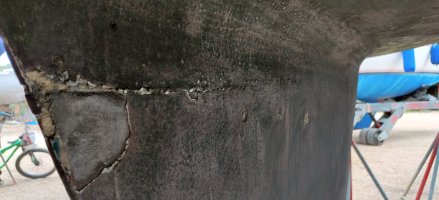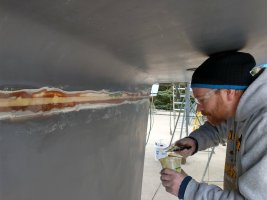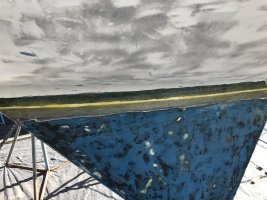yalcin
Junior Member
Greetings from Panama,
On our Ericson 38, we made some miles and ended up hauling out in Panama, in the middle of a jungle. This is a French operated DIY yard. The long list of our projects include installing a new shaft seal, eliminating rudder play and a new bottom paint.
Unfortunately, when we started to sand around the keel hull joint, what we thought as a simple paint crack turned out a bit of a bigger problem. We do not think the joint is compromised but we are confused about how they constructed this joint from the outside.

We can see the bedding compound (where the paint flaked off) and it seems in tact. There's some loose fiberglass we were able to peel off, and there's some foamy filler on the trailing edge of the keel. My theory is that they laid a layer of fiberglass cloth over the hull and the keel to get a smooth painting surface after fairing. Does this make sense?



We still have sanding to do in order to get rid of all the loose pieces. Has anyone encountered a similar problem? What's the best way to fair this surface for painting? Should we try to glass it like it was or will a simple epoxy putty do it?
On our Ericson 38, we made some miles and ended up hauling out in Panama, in the middle of a jungle. This is a French operated DIY yard. The long list of our projects include installing a new shaft seal, eliminating rudder play and a new bottom paint.
Unfortunately, when we started to sand around the keel hull joint, what we thought as a simple paint crack turned out a bit of a bigger problem. We do not think the joint is compromised but we are confused about how they constructed this joint from the outside.

We can see the bedding compound (where the paint flaked off) and it seems in tact. There's some loose fiberglass we were able to peel off, and there's some foamy filler on the trailing edge of the keel. My theory is that they laid a layer of fiberglass cloth over the hull and the keel to get a smooth painting surface after fairing. Does this make sense?



We still have sanding to do in order to get rid of all the loose pieces. Has anyone encountered a similar problem? What's the best way to fair this surface for painting? Should we try to glass it like it was or will a simple epoxy putty do it?




